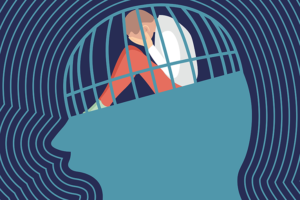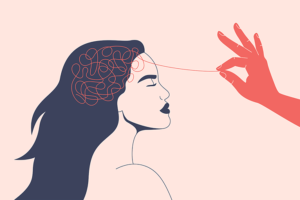By Katherine Ponte, JD, MBA, CPRP
A trigger, sometimes referred to as a stressor, is an action or situation that can lead to an adverse emotional reaction. In the context of mental illness, referring to triggers usually means something that has brought on or worsened symptoms.
In the ongoing dialogue about mental health, we don’t talk enough about triggers. Most often, the discussion focuses on what happens after a person has been triggered, which is when the situation is much harder to address. Understanding, identifying and working to prevent triggers can be more empowering and effective.
Understanding Triggers
Triggers are individualized experiences that vary widely from person-to-person. For example, a trigger may elicit a physical reaction, such as heavy breathing or sweating. A trigger can also spur an emotional reaction, like thinking “I am being attacked, blamed, controlled, disrespected, hurt and judged.” After experiencing a trigger, a person may feel overwhelmed, powerless, scared, unloved and weak, among many other feelings. These feelings can be very difficult to address and quite detrimental to mental health.
A person’s behaviors based on their emotional reaction can range from relatively minimal to serious, such as acts of violence. Someone exposed to a trigger while symptomatic may be more vulnerable and the emotional reaction may be stronger. Additionally, a trigger can impair judgment and some people may lack insight about their reactions.
It is important not to assume that you understand the emotional response of someone who has been triggered or suggest that someone who has been triggered is overreacting, being “too sensitive” or being irrational, even if the trigger may seem insignificant.
Types Of Triggers
Many different stimuli can be possible triggers, and they are often strongly influenced by past experiences. Personally, as someone who lives with mental illness, I have experienced numerous triggers when I’ve been symptomatic. These triggers have led to extreme discomfort, family conflict, onset of illness, worsening of symptoms, episodes and hospitalizations.
External triggers: In the summer of 2006, I became engrossed watching the inexplicable war and tragic loss of life in the middle east on CNN. This triggered a severe psychotic manic episode. Similar geopolitical events triggered me twice more. Each time I was hospitalized. To prevent this trigger from repeating, I stopped watching televised news.
Internal triggers: I was triggered by feelings of abandonment when my spouse avoided contact with me to minimize conflicts. I would at times spontaneously angrily erupt. To address these feelings, I talked to my spouse and let him know how our strained communications made me feel, and he reassured me that he had no plans to leave me.
Trauma triggers: I live near the hospital where I experienced a traumatic hospitalization. It was along a convenient route for me to access public transportation, but every time I walked by it, I recalled that hospitalization and was “re-traumatized.” After being triggered several times, I decided no longer to walk past the hospital and took a longer, alternative route.
Symptom triggers: A lack of or reduced need for sleep has occasionally triggered the symptoms of my bipolar disorder. In this situation, I quickly address any sleep disruption, often with a medication adjustment in consultation with my doctor.
Ways To Cope
There are many possible coping strategies. Strategies should seek to eliminate, avoid and reduce the impact of triggers and emotional reactions. Each person must identify what works best for them through trial and error. Different coping strategies may work for different triggers and emotions.
Learn to identify: Consider reactions to past triggers; who or what was involved, where, when and why it took place. Observe patterns and obvious signs of risk to prevent a similar situation (like ceasing to watch televised news).
Make a plan to address: Create a plan to address triggers and emotional reactions. You may want to talk to loved ones or your treatment team to let them know how they can best help you when you are triggered. Be sure to carefully address triggers that occur repeatedly, because each time they do, the emotional reaction may be greater.
Try problem-focused coping: Confront your stressor directly or try to find a solution to the stressor. For example, driving your kids to school may cause you to worry, because you’re afraid you might arrive late to work. Instead, you can ask someone else to drive your kids to school.
Try emotion-focused coping: When you cannot eliminate or avoid a trigger, focus on regulating your reaction to a stressor which may help reduce the stressor’s impact. For example, meditation can help reduce stress, anxiety and depression.
Communicate if someone is triggering you: A person triggering another person often does so unintentionally. Talk to them about their actions and their impact to clear up any misunderstandings and consider possible solutions. Have an open, calm and understanding dialog. Be willing to work with them. If the person who is triggering you refuses to act sensitively, it may be best to set clear boundaries.
Find the right therapy: Specific types of therapy have been shown effective in addressing triggers. Specific therapies especially helpful for addressing trauma triggers include exposure therapy and EMDR therapy.
Reality-check your thoughts: To minimize the escalation of thoughts and feelings, it may be helpful to “reality check” thoughts to assess their reasonableness. A few ways to do this include:
Fact checking: Consider the facts and whether they support your interpretation.
Apply cognitive distortions: Identify faulty or inaccurate think, perceptions or beliefs.
Reframe: Reshape automatic negative thoughts into positive thoughts.
Proportionality: Ask yourself, is the reaction disproportionate to the trigger?
Look for trigger warnings: Triggers warnings can help alert you to triggering material, especially materials related to suicide or violence. Sometimes, an article will provide a trigger warning at the start of the piece. You can even ask others to provide you with a trigger warning about materials they share.
Practice self-care: Prioritizing your mental health can help build resilience against potential triggers. You can start by talking to someone, such as a loved one, friend or therapist. You may also want to practice mindfulness, meditation, deep breathing or journaling.
It’s difficult to control our triggers; however, we can learn from our experiences. We can apply what we learn to manage and limit the risk of being re-triggered. We can’t diminish or dismiss the trigger or only focus on what happens after we’re triggered — we must also focus on what we can do beforehand.
Each time we’re triggered is a learning opportunity that can help us manage our reactions in the future. If we can’t control the trigger fully, we may be able to limit the emotional reaction to it before it becomes problematic and harder to address. We might even be able to prevent the trigger by preparing for it. We can have some control, and anything that gives us a little control over our mental illness can help keep us well.
Katherine Ponte is happily living in recovery from severe bipolar I disorder. She’s the Founder of ForLikeMinds’ mental illness peer support community, BipolarThriving: Recovery Coaching and Psych Ward Greeting Cards. Katherine is also a faculty member of the Yale University Program for Recovery and Community Health and has authored ForLikeMinds: Mental Illness Recovery Insights. She is on the NAMI-NYC Board.
Source: https://nami.org/Blogs/NAMI-Blog/January-2022/Understanding-Mental-Illness-Triggers




